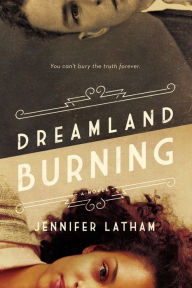Book Review: Dreamland Burning by Jennifer Latham
Publisher’s description
 Some bodies won’t stay buried.
Some bodies won’t stay buried.
Some stories need to be told.
When seventeen-year-old Rowan Chase finds a skeleton on her family’s property, she has no idea that investigating the brutal century-old murder will lead to a summer of painful discoveries about the past… and the present.
Nearly one hundred years earlier, a misguided violent encounter propels seventeen-year-old Will Tillman into a racial firestorm. In a country rife with violence against blacks and a hometown segregated by Jim Crow, Will must make hard choices on a painful journey towards self discovery and face his inner demons in order to do what’s right the night Tulsa burns.
ADVERTISEMENT
ADVERTISEMENT
Through intricately interwoven alternating perspectives, Jennifer Latham’s lightning-paced page-turner brings the Tulsa race riot of 1921 to blazing life and raises important question about the complex state of US race relations – both yesterday and today.
Amanda’s thoughts
That description up there does not at all capture how completely absorbing this book is. Which is good, because it also doesn’t give too much away and you’ll get to discover on your own just how compelling and unpredictable this story is.
Narrative duties are split between contemporary teenager Rowan, a biracial girl (her dad is white, her mom is black) in Tulsa and William, a 17-year-old in Tulsa in 1921. William is also biracial–his dad his white and his mother is Osage Indian. The bulk of the story is really William’s, though Rowan and her friend James (who is also biracial–black and Native American–and asexual) do the investigating that starting putting pieces of the mystery together. Rowan has her own story line, too—it’s just not as big as William’s. James calls Rowan out for living in a bubble. James is into social justice and immigration reform and doesn’t let Rowan get away with statements like “things are better now.” He schools her about racism, power, and privilege, leading her to taking a summer job at a clinic in an impoverished area (that’s less dangerous than just forgotten, she notes) when her other internship falls through. Here, she befriends people she otherwise wouldn’t have known. And though they are set nearly 100 years apart, it’s no surprise that the racism that drives William’s story is also a strong force in Rowan’s story. An unexpected incident propels Rowan to action—and, surprisingly, begins to weave her story more tightly with William’s.
William, who we follow in 1921, is sort of thoughtlessly racist, as you might expect a young boy in Tulsa, Oklahoma at this time to be. Language of the era permeates his story, with terms like “mongrel,” “half-breed,” “Negro,” and the n-word frequently used. William instigates a scene at a local speakeasy when he sees the white girl he likes hanging around with a black boy. He doesn’t think what consequences his actions may have when he and his friend lie and say he was attacked by the boy. But soon, he does start to think more about racism, and begins to look beyond the expectations of how a white boy in this era should act and think, when he meets siblings Joseph and Ruby Goodhope. William meets them at his father’s Victrola shop, where, despite Jim Crow laws, they sometimes sell to black people on the sly. And while William’s dad agrees to sell Joseph a Victrola, and even allows him to finance it, he won’t write him a receipt—he can’t risk the proof of the sale falling into the wrong hands. It’s through this sale, and the issue of the receipt, that William and the Goodhope siblings begin to interact. Young Ruby, who is irritating in that special way that pesky little sisters can be, starts to grow on William. So when things come to a head in his town and the KKK and other white citizens begin rounding up black people, killing them, and burning their neighborhoods, William’s first concern is making sure Joseph and Ruby are safe. And while we know the skeleton under Rowan’s family’s guest cottage floor belongs to someone from William’s story, we’re not sure who. Nothing is revealed quickly, and just when you think you’re sure you’ve figured it out, Latham reveals unexpected details that make you throw that theory out.
Maintaining two timelines with two narrators and keeping both equally interesting is not an easy task. Latham ties the stories together enough that we see parallels without being hit over the head with them. Both narrators are complicated, interesting figures, but seeing William’s emotional and intellectual journey is the far more satisfying story. Equally as satisfying is how Latham brings us to the end of the mystery. The tight pacing and action-packed, unpredictable plot make this book fly by. An author’s note at the end tells more about the race riots in Tulsa in 1921 and examines the controversial term. The note also points out a few resources for further reading. This book—a contemporary story, historical fiction, and a mystery, all at once—will have wide appeal. A gripping look at a shameful time in America’s history and (not that we need it) a reminder of how slow progress really is.
Review copy courtesy of the publisher
ISBN-13: 9780316384933
Publisher: Little, Brown Books for Young Readers
Publication date: 02/21/2017
Filed under: Book Reviews
About Amanda MacGregor
Amanda MacGregor works in an elementary library, loves dogs, and can be found on BlueSky at @amandamacgregor.bsky.social.
ADVERTISEMENT
ADVERTISEMENT
SLJ Blog Network
Should I make it holographic? Let’s make it holographic: a JUST ONE WAVE preorder gift for you
Review of the Day: Every Monday Mabel by Jashar Awan
Betty and Veronica Jumbo Comics Digest #334 | Preview
Fifteen early Mock Newbery 2026 Contenders
When Book Bans are a Form of Discrimination, What is the Path to Justice?
ADVERTISEMENT







